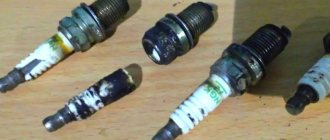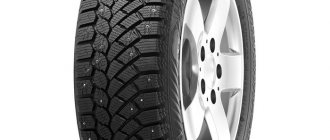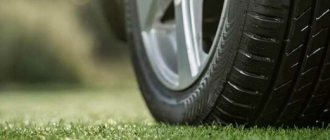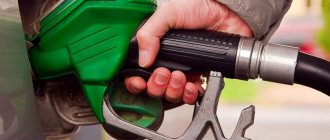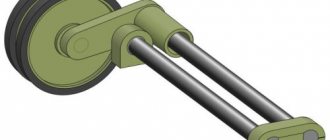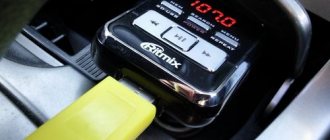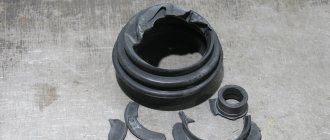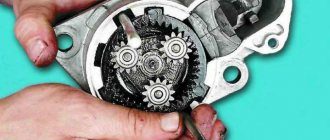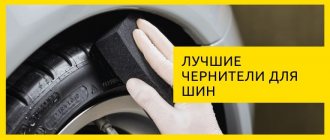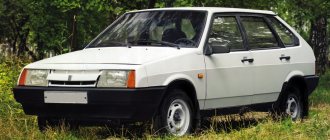What is a CV joint?
CV joint (constant velocity joint) is a movable chassis unit used in cars with front-wheel drive and all-wheel drive. This mechanism was invented by Alfred Rzepp in the 20s of the 20th century, and by the middle of the century it had become widespread in various automotive equipment.
The CV joint serves to transmit torque to the idler wheel from the gearbox, as well as transmit rotational motion from one axle shaft to another. The rotation angle of this part is up to 70°, but, most often, this value does not go beyond 20°.
This unit is distinguished by a huge margin of safety, often exceeding the service life of the vehicle, has a small weight compared to a cardan clutch, and also significantly reduces tire wear.
There are the following types of such hinges:
- Tripod (used as an internal CV joint)
- Cracker (used on trucks)
- Twin hinge (practically not used due to its complex design)
- Ball / CV joint Receiver (used in passenger cars on axles)
The tripod CV joint is used to compensate for axial movements.
This unit consists of a housing, inside of which there is a three-beam fork, the operation of which is ensured by rollers based on needle bearings. This design allows both angular and axial movements. During rotation or axial impacts, the rollers move in the guide grooves of the housing. This type of joint is used as internal CV joints for wheel drive. Cam joints are used only in trucks. This is due to the fact that this technique has a low angular rotation speed, so the CV joint will not overheat.
Paired joints are two cardan shafts fastened together. This design allows you to compensate for their uneven rotation. These CV joints were installed on American cars of the 20s of the 20th century, and later on American SUVs. Today they can be found in some models of tractors, construction equipment and trucks.
The ball CV joint is used to transmit rotation using metal balls sliding in special grooves in the body of the unit. This type of part is used as an outer wheel joint in modern front-wheel drive vehicles. This is due to the ability of the CV joint to transmit high torque, a large rotation angle and minimal play between the elements.
Due to the design features, the ball CV joint is not capable of compensating for the axial movements of the suspension and transmission units. Other parts serve these purposes.
The correct functioning of the entire drive is ensured by two CV joints: internal and external. The first one is larger in size than the second one. The inner CV joint is used to transmit motion from the transmission to the shaft. The outer hinge drives the wheel hub, for which it has mounting splines.
CV joint design
At the beginning of the last century, many CV joint designs were developed, which are used to this day. For example, cracker or cam, cam-disk, ball with dividing grooves or with dividing levers, with spherical rollers and a fork, paired cardan shafts. All CV joints have both advantages and disadvantages. The performance of each design is better for some conditions and not so good for others. Therefore, there is no question which design is more successful.
For external drive joints of modern fast passenger cars, the characteristics of a ball joint with 6 balls turned out to be better. The CV joint body and the inner ring under the separator, which keeps the balls from falling out of the CV joint, have the same number of grooves for them. The connection of the inner ring with the drive and the CV joint housing with the hub is splined. At large angles of rotation of the drive wheels, the maximum permissible torque transmitted by the hinge is much less than at small angles. Therefore, for long-term trouble-free operation of the CV joint, it is necessary to prevent it from working with a heavy load in the extreme positions of the steering wheel. Each CV joint is necessarily protected by a boot.
Tripoids are often used as internal grenades. They are less mobile, but more wear-resistant, since needle bearings are used in their design.
Malfunctions
Modern CV joints used in automotive technology have a very long service life, comparable to the service life of the vehicle. However, they can also fail, often completely unexpectedly for the car owner.
The most common cause of CV joint failure is a leaky boot. The reason for its wear is bad roads and frequent driving over rough terrain.
During operation, road dirt, moisture, reagents and other contaminants penetrate into the unit through a damaged casing. Mixing with the lubricant embedded in the part, an abrasive paste is formed, which causes severe wear. First, there is a crunch when turning, and then jamming or loss of the bearing rollers occurs.
The next cause of breakdown is an aggressive driving style and illiterate intervention in the design of the vehicle. It should be remembered that a civilian car is not designed for frequent braking by the transmission and sudden starts with slipping. When starting with the wheels turned out, when the CV joints are partially blocked, very high loads occur on the hinge elements.
Owners of tuned cars are also at risk. This is due to the fact that when accelerating the engine, they simply forget about upgrading standard drives and CV joints, which are not designed to transmit additional torque and load.
The last reason why hinges fail is the aging of the lubricant inside the assembly. This is a natural process from which no one is immune. Therefore, in order to prevent malfunctions, along with inspecting the condition of the anthers, it is necessary to replace the lubricant.
Types of lubricants
Over time, more and more different lubricants appear on the market. They differ in their composition and properties. Based on their composition, lubricants are divided into two main categories:
- Lithium;
- Based on molybdenum disulfide.
Lithium greases
Lithium lubricants for CV joints are the most common and affordable option. Photo: ad-cd.net
The most common type of lubricant for transmission maintenance. The substances have a yellowish substance with excellent viscosity, which thickens at low temperatures.
Lithium compounds are characterized by high conservation properties, which have a pronounced anti-corrosion effect. This lubricant also copes well with dust and dirt that gets into the mechanism, but it does not solve this problem as a whole. The drive system should be serviced every 40-50 thousand kilometers.
Most lithium lubricants are neutral to the polymer materials from which modern CV joint boots are made.
In such cases, you should look at the operating instructions, which should contain recommendations for servicing the CV joints and the compounds used for lubrication.
- Widespread due to low cost and fairly high efficiency;
- React with polymeric materials;
What should the lubricant be?
The cause of vibrations during acceleration and movement is usually a violation of the integrity of the boot and dirt getting inside the CV joint. In this case, servicing the hinge and replacing the protective cover can help.
At the same time, you should not use the first lubricant that comes to hand for this. Since needle bearings are installed in the unit, the consistency of the lubricant should not exceed NLGI-2. The most optimal products for these purposes will be products with a consistency of NLGI-1 and NLGI-1.5. It is for this reason that you should not use various lithols that have a consistency of NLGI-3. This is interesting: Effectively flushing the car cooling system: which product is better
Needle bearings used in tripods require the use of pure lubricants with anti-caking and anti-wear properties without the addition of any solid lubricant particles. When using graphite or molybdenum compounds, wear of the assembly may increase.
You should also pay attention to the operating temperature range of the lubricant. The fact is that the internal CV joint is located in close proximity to the engine, which is why the unit can heat up to high temperatures above +100 °C.
Lubricant for tripod CV joints should be polyurea based. This is because such materials must be heat-resistant, as well as withstand high loads and prevent wear. In addition, polyurea-based lubricants are used for the entire service life of the unit (about 150 thousand kilometers).
You can find recommendations for the use of compositions based on a lithium complex as tripoid CV joint lubricants. In reality, this is not the best solution. The thing is that, unlike polyurea, such lubricants are less heat-resistant and have poorer resistance to oxidation. Yes, lithium complex materials will work in the tripod joint, but they will have to be replaced more often.
In what cases does the CV joint lubricant change?
- When replacing a torn boot. In this case, it is necessary to change the lubricant
- After 100 thousand kilometers or after 5 years of operation of the CV joint.
If the drive is crunchy, it is too late to change the lubricant in it. The drive itself needs to be replaced. This is explained by the fact that if the hinge crunches, it means that it already has significant wear and no matter how much you change the lubricant in it, it will not get any better. To determine which of the joints has crackled, you need to select a flat asphalt area and drive along it, turning the steering wheel all the way to the left, and then all the way to the right. At this time, the assistant, being outside the car, must evaluate in which case the crunch is louder. If the sound is louder when the steering wheel is turned to the left, then the left outer drive needs to be replaced. When the crunch is louder with the wheels turned to the right, you need to change the right outer drive.
Polyurea based lubricants
Advertisements from manufacturers of lubricants for special automotive components attract the attention of motorists. Of particular interest are lubricants made with polyurea.
First, let's decipher the complex name, that is, what it means.
Lubricate the unit for the entire service life. Changed during maintenance. This lubricating consistency has a number of advantages over other analogues. The lubricant holds high temperatures, does not destroy thermoplastic, and is waterproof. Polyurea thickener in sublimation with basic lubricating consistencies, non-traditional additive materials, guarantees durability and resistance to uncomfortable conditions of use.
When using this lubricant, it is necessary to systematically monitor the joints for the possibility of fluid leakage.
Main types of lubricants
At the moment, there is a fairly large selection of lubricants for CV joints, which differ in their composition. They may also differ in their efficiency, price and operating features. Now we will talk in more detail about all popular types of lubricants.
Lithium
They arose almost immediately after the CV joints themselves. As a result, such a substance is in good demand.
The composition is based on a lithium solution and organic acid. The result is a yellowish, viscous substance that thickens as temperatures drop, making it much more difficult to spread in winter. Using compositions of this type, it is possible to reduce the load on drive elements by a couple of tens of times.
You may also be interested in: Frame SUVs with all-wheel drive: ranking of the best models
At the same time, we are pleased with the high preservative properties of the substance. It prevents dust, dirt, moisture and other elements from penetrating metal elements. At the same time, such compositions are very aggressive, so they can dissolve anthers. Read the manual for your car. It indicates whether the use of lithium substances for lubricating joints is permissible.
Recently, lubricants of this type have become somewhat less popular, giving way to more innovative options. At the same time, they can still be found on the market. The most popular options now are XADO, Very Lube and RENOLIT.
Molybdenum
A more progressive option, which is made from the same lithium soap, only now the additive is molybdenum disulfide. Lubricating properties are the same as the previous version. At the same time, molybdenum compounds have one important advantage - they have high anti-corrosion properties.
This was achieved by using metal salts in the composition, which replaced some acids. In addition, the substance is completely safe for rubber and plastic elements, so it will not lead to premature wear of the boot.
One of the disadvantages of such a substance is its low resistance to moisture. As a result, if even a little water gets under the boot, due to certain chemical reactions the composition turns into an abrasive. This only promotes friction, which leads to a number of CV joint failures. To prevent such a situation, it is necessary to regularly check the node.
There is also an opinion that the use of molybdenum lubricants leads to the restoration of damaged transmission components. This statement is incorrect, so if you hear a crunching noise in the CV joint, it is better to contact the service center technicians.
Among the most popular options available in our country are CV joints-4 and LM47 lubricants.
Barium
Recently, such CV joint lubricant has been in increasing demand on the market. The progressive composition allows you to extend the service life of the hinge, as well as protect it from a number of negative influences. The main advantage here is that the substance is not at all afraid of moisture.
Thus, if the boot ruptures, there is no need to change the substance. In addition, the lubricant has excellent corrosion resistance and is also suitable for use even in fairly aggressive conditions. The composition is chemically neutral, so the anthers will not be damaged, regardless of the material of the seals.
The main disadvantage of such a substance is its relatively high price, which is caused by the complexity of the production process. We produce only ShRB-4 lubricant; everything else has to be purchased in other countries.
At the same time, the latter option is even more expensive. Another drawback of this composition is its inability to withstand low temperatures.
Do tripoid CV joints need to be lubricated and why?
Ask any car enthusiast why lubricant is needed, and he will tell you with confidence that it is to protect parts from wear and to improve the sliding of individual elements during interaction. At the same time, not everyone knows that a high-quality substance has a number of remarkable properties that reduce the load on components. The last factor is very important, since many elements operate under very difficult conditions, for example, at high temperatures and constant friction.
Lubricant for CV joints must be selected very carefully, since it will have to perform a number of additional functions. Such compositions can greatly reduce fuel consumption and reduce transmission losses in a car.
An essential characteristic is that the substance does not allow corrosion to develop, since it is rust that often causes tipoids to fail. And yet, the material should not harm polymers and rubber, since some elements are made from these substances. If the lubricant is too aggressive, it will simply dissolve such materials.
The principle of choosing lubricants for CV joints
Lubricants for constant velocity joints are selected according to a fairly simple principle: depending on the type of unit that ensures the transmission of rotational motion at an angle. All CV joints are structurally divided into two groups:
- ball type;
- tripods.
In turn, ball-type hinges can have two designs: with the possibility of axial movement and without such a possibility. Tripods provide axial movement by default.
Ball joints without axial movement are usually used on the outer part of the axle shaft, that is, they connect the axle shaft and the hub. Tripods or ball CV joints with axial movement are usually internal and connect the gearbox to the axle shaft. Read more about the type of hinge design on your car in the instruction manual.
This is interesting: Options for opening the hood on a VAZ 2110 when the cable breaks
Ball CV joints require increased protection against scuffing, since the balls are in point contact with the races and, as a rule, do not roll, but slide along the working surfaces. Therefore, extreme pressure additives and molybdenum disulfide are widely used in lubricants for ball CV joints.
The tripods have needle bearings, which require protection from contact loads of a different nature. And the presence of a large amount of extreme pressure additives, as well as solid molybdenum disulfide, as practice has shown, negatively affects the life of the tripod .
Lubricants for CV joints are highly specialized. That is, they are recommended for installation specifically in joints of equal angular velocities and nowhere else. They are designated by two main markings:
- "For CV joint";
- "Constant Velocity Joints" (may be abbreviated as "CV Joints").
Next, it is usually indicated for which specific type of CV joint it is used. Ball-type outer CV joint lubricants are labeled NLGI 2, Molybdenum Disulfide or MoS2 (indicating the presence of molybdenum disulfide, suitable only for ball joints). Lubricants for tripod CV joints are marked as NLGI 1 (or NLGI 1.5), Tripod Joints or Triple Roller Joints.
But more often on lubricants it is written as clearly as possible: “For ball CV joints” or “For tripods”.
Also pay attention to the minimum permissible operating temperature of the lubricant. It varies from –30 to –60 °C. For northern regions, it is better to choose a more frost-resistant lubricant.
What problems do CV joint lubricants solve?
Even a novice motorist knows that the lubricant, which is used in most components, solves not only the problems of reducing friction and wear of parts. It is also designed to reduce the load that the mechanisms experience. Lubricants make rotation easier and more freely, and the car can move forward without any obstacles. In addition to reducing friction, CV joint lubrication also reduces fuel consumption and energy loss in the transmission.
The second equally important property of lubricants is the protection of metal components from corrosion. It's no secret that the bulk of all breakdowns of parts in mechanisms are the consequences of cavity corrosion. The lubricant should protect the CV joint parts from such processes and thereby ensure the durability of the unit. A good product will save the car owner from unnecessary costs.
Which CV joint lubricant is best?
In terms of choosing a specific manufacturer, experienced motorists recommend the following method.
If you have purchased a new inexpensive outer CV joint or are repairing a joint that has lasted several tens of thousands of km (for example, the boot is being replaced), you don’t have to bother with buying expensive lubricant and use a budget option. The main thing is to put it in sufficient quantity. For example, inexpensive domestic lubricant “CV joint-4” or “CV joint-4M” is quite suitable for this purpose. Considering that the outer CV joint is relatively easy to change and is generally considered a consumable, many car owners do not see the point in overpaying for expensive lubricant.
If we are talking about an internal tripod or an expensive hinge of any design from a renowned manufacturer, it is better to purchase a more expensive lubricant. It will help increase the already high initial resource of high-quality spare parts.
When choosing a specific brand of lubricant, the rule works well: the more expensive the lubricant, the better it is. There are now several dozen manufacturers on the market, and you can easily find both positive and negative reviews about each brand.
The point here is that it is difficult to objectively compare the performance of lubricants in CV joints. There are too many variables in the evaluation equation: the amount of lubricant used, the correct installation, the reliability of the boot insulating the working cavity of the CV joint from the influence of external factors, the load on the unit, etc. And some motorists do not take these factors into account, and blame everything on the lubricant or the quality of the part.
It is also important to remember that it is impossible to put general-purpose lubricants like lithol or “graphite” into the CV joint, regardless of design.
EFELE MG-212
EFELE MG-212 is the best grease for external CV joints. Made from high quality mineral oil thickened with lithium soap. The material contains extreme pressure additives and molybdenum disulfide. Operating temperature range from -30 to +120 °C.
In addition to internal CV joints, the lubricant can be used in chassis components of tractors, cars, bulldozers and other vehicles operating in harsh conditions, equipment components in the woodworking, polymer industry, metallurgy and other industries.
Suitable for heavily loaded bearings of general industrial equipment, fan bearings and electric motors.
EFELE MG-212 has increased load-bearing capacity, works in damp, dusty environments, under conditions of shock loads, is resistant to washing off with water, and has excellent anti-wear properties. It has the properties of an anti-emergency lubricant and perfectly protects against corrosion.
EFELE MG-212 is characterized by low cost and high performance characteristics, thanks to which it can be used in a large number of equipment and machinery.
Molykote BR 2 Plus
Molykote BR2 Plus is a mineral oil based lithium grease. Used in components of industrial equipment and machinery for long-term lubrication. Operating temperature range from -30 to +130 °C.
In addition to external hinges, it can be used in friction units of equipment in the metallurgical, cement, ceramic, polymer, printing, and woodworking industries. Also suitable for chassis components of material handling machines.
The lubricant has high load-bearing capacity, high anti-corrosion and anti-wear properties, works in dusty and humid environments, and has the properties of an emergency lubricant. It is wash-resistant, prevents jerking, protects against fretting corrosion and has a long service life.
Molykote BR2 Plus also has high performance, but in terms of heat resistance and cost it loses to first place.
Liqui Moly 47 Langzeitfett
Liqui Moly 47 Langzeitfett is a mineral lubricant based on a lithium complex with the addition of molybdenum disulfide and extreme pressure additives. Operating temperature range from -35 to +120 °C.
The material is designed for loaded and high-speed bearings. Can be used for the maintenance and repair of tools, machines and vehicles. In addition to bearings, it is suitable for spline joints, pins, guides, crosspieces, steering rods.
The lubricant is resistant to hot and cold water, reduces wear and friction, and prevents corrosion. It is resistant to aging, can withstand increased loads and is suitable for use in CSS.
Unlike previous materials, Liqui Moly 47 Langzeitfett is not as versatile, and the characteristics of the material are inferior to previous materials.
Gazpromneft CV joint
Lithium waterproof grease based on mineral oil and molybdenum disulfide with the addition of functional additives. Operating temperature range from -40 to +130 °C.
The material is used in constant velocity joints and other automotive components.
It is water-repellent, maintains consistency at low and high temperatures, and forms an oil film that prevents direct metal-to-metal contact, corrosion and seizing, seizing, jamming and welding.
In terms of characteristics, the Gazpromneft CV joint is similar to the previous material in terms of characteristics, but is inferior to all others in terms of quality. Despite the low cost - only 4th place.
CV joint MS
Metal-clad anti-seize grease based on lithium soap. Contains a highly adhesive polymer. Operates in a temperature range from -40 to +140 °C.
This is interesting: What to do if the fan (motor) of the Ford Focus 1 heater does not work and how to fix it
Used in constant velocity joints and other friction units operating under shock loads. Suitable as a lubricant for conveyors, winches, gear and chain drives of general industrial equipment.
The lubricant is moisture resistant, has extreme pressure characteristics, protects the CV joint in the event of moisture and dust ingress when the boot is damaged, and is compatible with the boot construction materials.
If we consider only the characteristics declared by the manufacturer, then CV joint MS is a good lubricant. But, judging by the reviews of car owners, it often does not correspond to the description and does not cope with its functions.
Main characteristics of the lubricant composition
Since it is important for many motorists that the lubricant performs all its stated functions, manufacturers are trying to develop formulations whose characteristics allow this to be done. If you try to list the parameters that such products have, you will get the following list:
- wide range of temperatures during use - up to 100 degrees Celsius, and sometimes more;
- ensuring strong adhesion to the surface, in other words, the lubricant is very sticky;
- excellent anti-scuff properties. The composition ensures normal sliding of the part over a long period;
- stability in mechanical, physical and chemical terms. It is extremely important for manufacturers that the lubricant retains its properties regardless of the external environment and loads.
All these parameters characterize the mixtures as high-quality and highly functional compositions. The products have good technical characteristics. parameters due to its unique composition. It should be noted here that products from different brands may have different compositions. Some details about CV joint lubricants can be found in the video:
What lubricants should not be used
There are also a number of compounds whose use is not recommended. Among other things, it is worth highlighting the following types of compositions:
- graphite. Such substances are suitable as a lubricant for bearings and a number of other elements in electric motors. The use of graphite lubricant on CV joints is inappropriate, as this will lead to failure of the unit after 20-25 thousand kilometers. In addition, low-quality substances are often added to such compositions, which only further accelerate the wear of moving parts;
- hydrocarbon (including technical petroleum jelly). Yes, such compositions prevent the penetration of moisture and also inhibit the development of corrosion. At the same time, when the temperature reaches 45 degrees Celsius, the substance will begin to break down. Since the temperature in the CV joint is an order of magnitude higher, the use of hydrocarbon compounds will lead to deformation of the unit over time;
- consistency compositions made from calcium or sodium. They are suitable for bearings and a number of other moving joints, but in the case of CV joints they show complete incapacity and also contribute to the development of corrosion. After only 15-30 thousand kilometers, metal elements can completely fail;
- zinc. Such compositions, like iron-based substances, are completely contraindicated as transmission lubricants, since they lead to a deterioration in its functional characteristics, as well as complete failure.
How often to change the lubricant
As a rule, replacement is required after 50-60 thousand kilometers, but here you need to read the instructions - for some manufacturers the lubricant service life can reach as much as 100 thousand km.
In addition, if the vehicle has not been used for 9 months, or has been rarely used for 18 months, then it is also recommended to replace the substance. At the same time, in some cases the composition must be replaced prematurely, so it is worth checking the condition of the lubricant sometimes.
You may also be interested in: DVR with radar detector: how to choose the best device
We strongly recommend that you regularly change the CV joint lubricant, following the instructions and rules established by the vehicle manufacturer. Remember that the cost of such a procedure will be an order of magnitude lower than repairing or replacing the hinge itself. As for the choice of substance, the modern market offers a fairly large assortment of lubricants. There is no need to save money and buy the cheapest substances. It is better to trust trusted manufacturers. Moreover, the difference in price will be relatively small.
Next is a video about the best lubricant for CV joints:
Maintenance of tripod CV joint
Servicing the tripod joint is a fairly simple procedure. First you need to jack up the part of the car where servicing is planned. Then the wheel and hub nut are dismantled. The ball joints are folded back and the clamp that tightens the inner joint boot is loosened, we bend the struts and remove the entire CV joint. After this, the inner ring is removed and the hinge is removed.
Next you need to clean everything from old grease. You should not use ordinary solvent for these purposes. It is better to use special means. Paper towels and clean rags are also useful for cleaning.
Next, you need to put fresh lubricant on the bottom of the bowl and assemble the hinge, then install the retaining ring. After this, we put the CV joint on the axle and check that the tripod marks match. Next, put lubricant on top of the assembly and a certain amount into the boot. We assemble in reverse order.
This completes the service. Remember that with regular inspection of the condition of the boots and the use of the correct lubricants, you can significantly increase the service life of the tripod CV joint.
How to properly change the lubricant in CV joints
Correct lubricant replacement. Replacing the lubricant in CV joints is done due to its contamination after the boot ruptures or its service life expires when it contains a lot of wear products. It is necessary to completely remove the old grease from the joint to eliminate the possibility of increased wear of the CV joint. To do this, it should be disassembled and thoroughly wiped with a clean rag. It will not be possible to wash it without disassembling it, because the grease is extremely difficult to wash off.
Retaining ring
There are usually no difficulties with disassembling the internal hinge, so we will describe disassembling the external one. If you do not have a special tool for removing the outer hinge, then remove the drive assembly and clamp it in a vice. Remove the clamps from the boot. When removing, try not to damage them; the factory ones are usually better than those that come with the new boot. If the cover is torn, cut it off with a knife; if not, slide it onto the drive rod. Use a hammer to knock the joint off the drive using a drift on the inner ring. Turn the inner ring with the separator so that the holes in the separator are visible, and the symmetry axes of the separator and the housing will be perpendicular. Using a flathead screwdriver, remove all the balls from the separator. In the separator, two of the six holes are longer than the others. Turn the separator so that they are pressed against the walls of the housing and remove the separator with the inner ring from the housing. After adjusting the position of the inner ring, remove it from the separator. Remove any remaining grease from the parts as best you can, and the hinge can be assembled.
Insert the inner ring into the cage. Orient the cage so that the long holes in it are pressed against the hinge body, and insert the cage and ring into the body. Insert the balls into the holes of the separator and rotate the inner ring so that the hole for the drive is located along the axis of the housing. The unit requires from 120 to 150 g of lubricant. How much will fit in your case depends on the size of the hinge.
To properly fill the joint with lubricant, clamp it in a vice with the drive hole facing up.
If you bought the lubricant for it in tubes, then press it into the hole under the drive, pressing the tube more tightly to the ring, until it appears between the separator and the housing. If you have it in a different package, then put it on with a spoon and press it into the hole for the drive with a cylindrical object of suitable diameter; The filling criterion is the same.
When installing the boot, do not put a lot of grease into it, otherwise it will tear it apart while the boot is working. Before tightening the boot clamps, lubricate the grooves for them with lithol.
Indiscriminate replacement
You can replace the lubricant in the CV joint without removing its components. To do this you need:
- Remove the CV joint itself from the car.
- Insert the tip of the tube and press the oil into the assembly.
- Press the tube tightly and wait until the color of the substance changes to fresh.
- Wipe the part, removing excess substance.
- Put the part in place.
Attention! This method has one drawback - a thin layer of old substance remains on the walls of the parts inside.
There is no need to rush to use the lubricated unit when driving. It is worth turning the assembly in place while the car is suspended on jacks. This is necessary to evenly distribute the lubricant over the parts.
Attention! On a car with an automatic transmission, with the wheels hanging, the pressure in the system will quickly drop.
The replacement process is not that complicated and if you have a minimum set of tools and skills, you can easily do it yourself. This will save money and allow you to get a better feel for the car. And remember, high-quality replacement of lubricant in CV joints cannot be done without removing it. If it is not possible to remove the assembly, then it is better to go to a car service center and see specialists.
- How to change the front silent blocks on a Mercedes 211 4matic
- How to change silent blocks on a Daewoo Nexia
- How to change silent blocks on Mazda cars 3-6
- How to change silent blocks on a Chevrolet Aveo: video
Important features and summary
When solving such an important task, it is worth performing several sequential actions:
- Read the vehicle's operating instructions. In this useful book you can find all the recommendations of specialists for servicing all components and assemblies.
- Determine the properties of the materials from which the CV joint is made.
- Determine the frequency of replacing lubricants depending on the operating loads of the vehicle.
- It is worth calculating the funds that will be spent on the purchase of lubricant.
When purchasing a lubricant, you should pay attention to the components it contains. In addition to the above, there are also substances based on graphite, minerals, zinc, iron, etc. These products are mainly used to lubricate various types of bearings in other components and assemblies.
To summarize, it can be noted that the most optimal in terms of price-quality ratio are lubricants based on molybdenum sulfide. They have a number of advantages over other competitors and, while maintaining the tightness of the boot, provide reliable protection for the CV joint.
